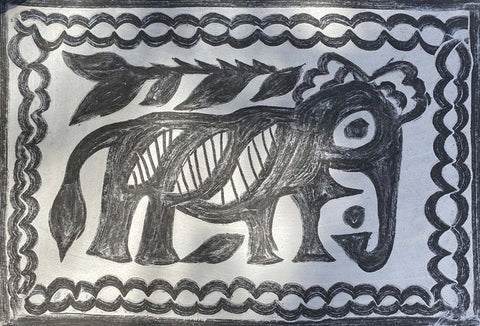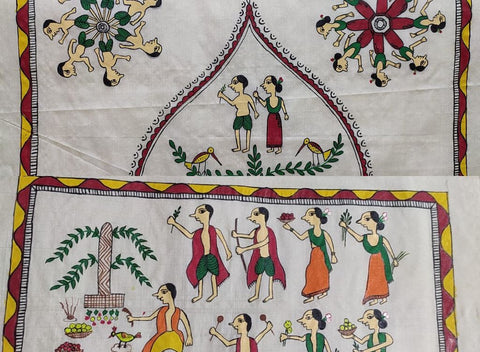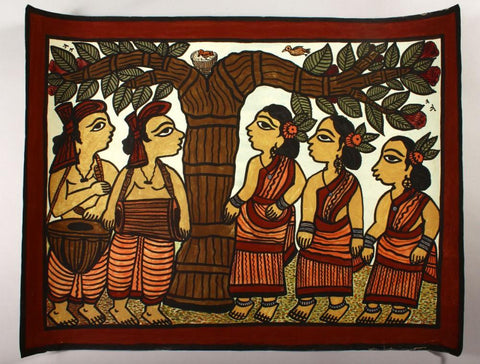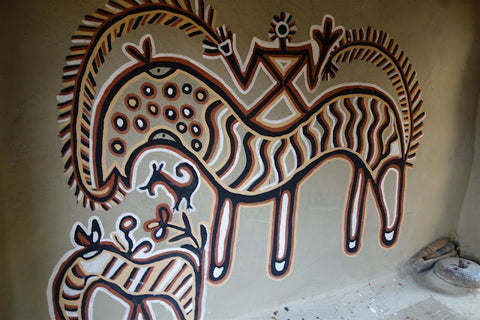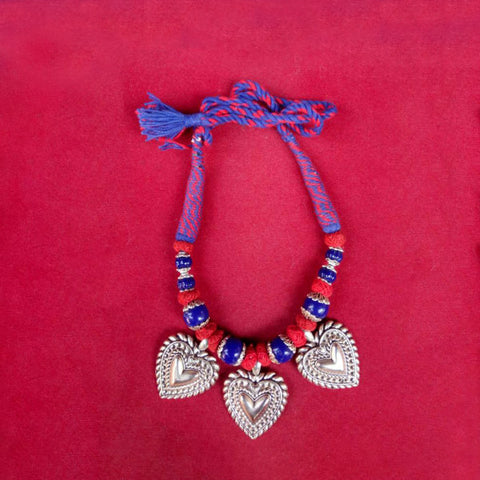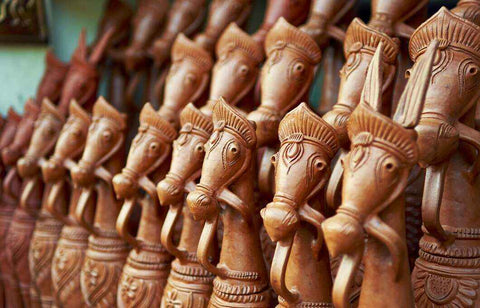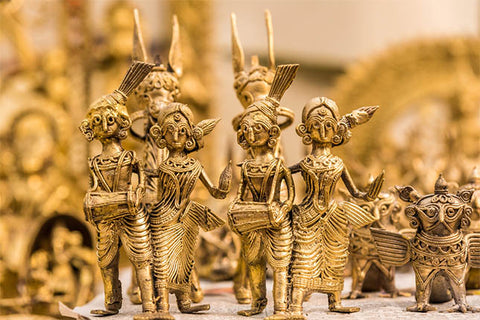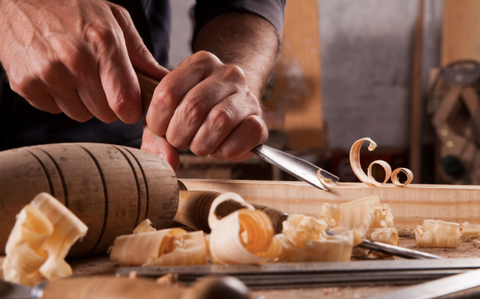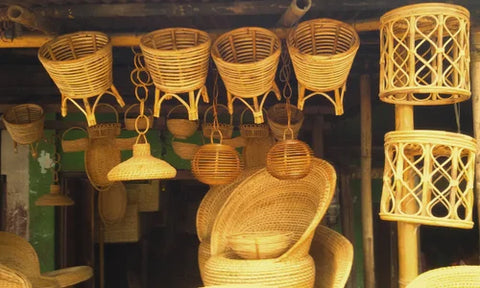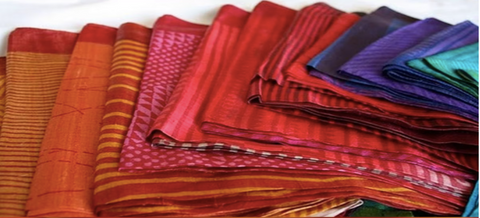Jharkhand, with its numerous Adivasi communities such as Munda, Oraon, Ho, Banjara, Bihor, and Santhal, along with its lip-smacking cuisines like chirka-roti and malpua, vibrant tribal dances, and boasting some of the largest steel factories, is also a haven to the craft traditions that continue to mold and define its aesthet ic territory. It is impossible for a state with a rich tapestry of tribes to not exhibit a pastiche of artistic expressions. Jharkhand is the epitome of all this fusion, which makes it an authentic bastion of artistic tradition.
Sohrai Paintings
With its striking bold lines and signature monochromatic colours, Sohrai is a distinctive art as well as a festival that celebrates the harvest in many adivasi (tribal) villages of Jharkhand. The word Sohrai translates to “to drive with a stick”, and justifying its name, these mural paintings are created using datun or chewed neem sticks. Sohrai art is prevalent among thirteen villages of Hazaribagh district, apart from other villages of Jharkhand. Sohrai paintings are a gem in many ways. Firstly, they are the symbol of an unbreakable, umbilical bond shared between mother and daughter. How? Quite like the Madhubani paintings, these mud-wall paintings are passed down from mothers to daughters, which also tells us about the space and autonomy the tribal women collectively have been sharing down the history. Secondly, Sohrai wall paintings are ecocentric in more than one way. Of course, on one level, many motifs, like bulls, elephants, trees, fishes, etc, that are directly taken from the natural flora-fauna we witness in Jharkhand, on the other level the colours applied by the Adivasi women are also natural, using clay, various forms of mitti or mud and charcoal. Thirdly, the art of creating Sohrai inherently embodies an intrinsic concept which is highly allegorical. The black soil that covers the wall is believed to be a symbol of a mother’s womb, and the white earth that is put above the black is a symbol of a light or sperm, while the red line that follows, is a symbol of procreation.
Khovar paintings
The name Kohvar is derived from the word ‘Koh’ which means cave, while ‘Var' refers to the husband, it circumscribes the relation of a man with a woman. Consequently, this mural art is done on the walls of the house of newly-wed bride and groom. Spring serves as the ideal season when the Kohvar is brought to life with renewed interest as fingertips are dipped in natural pigments. During other times, datun or neem sticks are dipped in duddhi matti (white mud), kali matti (manganese black), pila matti (yellow ochre), lal matti or geru (red oxide) to embellish the mud walls with larger-than-life elements such as fishes, peacocks, animals, lotuses and more. While both Kohvar and Sohari are created for different purposes, many of the motifs that are prevalent in Kohvar murals are similar to those seen in Sohari.
Jadopatia Painting
Whether through the oral tradition of passing down powerful Vedic hymns, legendary episodes or through writing done on palm leaves, ancient Indians had consistently found ingenious ways to trickle the elixir of epics and ideas from one generation to the next. Following the same tradition, scroll art emerged as an extension. Imagine a generation sans phones, internet, laptops, and other digital devices. Yet, by no means was this generation pleasure-deprived, they had their share of cinematic experiences through natak (dramas), puppetry, and scroll narratives.
Portable scroll art has been a part of India for aeons and there still exists diverse regional versions such as Pattachitra in Orissa, Cheriyal in Karnataka, Phad in Rajasthan and Jadopatia in Jharkhand. The Santhal tribal community, for instance, adopted Jadopadia scroll art as a form of education and entertainment. Gods, clan deities, legends, and local lores are given a dramatic touch with vibrant pigments. From the use of palm leaves to paper mediums, and traditional paints made from tree barks and minerals to modern watercolours, Jadopatia scrolls have come a long way. Yet there is so much rustic earthiness still present in them.
Paithkar
Another creative expression that comes into the forefront of defining the state’s tribal heritage, lifestyle, ritual, and festivals is the Paithkar scroll art. Mahabharata and Ramayana also become fundamental from which various themes spring out to give a language to the scroll art. Some of the common defining features of Paithkar scroll art are as follows:
- It is the juxtaposition of human life and death.
- The use of brownish-yellow colours and a similar colour palette
- Human bodies possess rounded features, and notable eyes, along with a notable resemblance to one another
Amadubi village of Jamshedpur district is where one can find the Chitrakar community whose existence sustains the rustic art of Paitkar painting. Not only the motifs but even the colours are directly sourced from nature. Tree barks, flowers, soil, and stones are some of the core elements from which pigments are derived.
Kurmi painting
Teli, Prajapati, Sohari, and Kurmi are some of the local tribes that have adopted a style closely related to prehistoric iconography. The semi-Hindu tribal community of Kurmi lives in one of the densely packed forest areas of Jharkhand. Speckled and striped animals, quadrupeds with long necks, and horned deities are some of the visible life forms that are chosen by the Kurmi women of Bhilwara province to paint the walls of their household during the harvesting season of October and November. The same naturally derived yellow, red clay ochre which are employed in the Kohvar and Sohrai paintings is employed here as well.
Tribal Ornament
Deeply imbued in symbolism is yet another celebrated craft of Jharkhand, and that is the indigenous tribal ornaments. Tribal jewellery not only informs us about the skills of the makers involved in jewellery-making but also about the socio-ethnic groups associated with it. These jewels are made from humble and accessible raw materials like silver and beads. They not only carry a rustic charm but are also pretty sophisticated to look at. It is a matter of pride to ostensibly display their well-decorated ornaments on different body parts- beginning with tikuli on their foreheads, moving to hasuli on their necks, and to kardhani on their waists, with the list being endless. While their chains hold little chimes, Santhali and Munda women also sport delicate earrings crafted in filigree and beads.
Terracotta
India has one the largest varieties of terracotta in the world, and this comes as no surprise. As far as the genesis of clay craft and terracotta in Jharkhand is concerned, the tradition can be dated back to the Mauryan period. Terracottas are the earthenwares which are obtained by baking the red clay. Just like in many parts of Northern India, it is the Kumhars or the potters, who are responsible for carving and firing the clay figurines and items into functional or decorative pieces. From birds, elephants and horses to water jars, vases, and lamps. These decorative items can also contain potent meanings. For example, horses are associated with power and strength.
Dhokra Crafts (Lost Wax Technique)
Much of the beauty of many Indian crafts lies in their inherent antiquity, a quality that is also intertwined with the element of sustainability that goes into crafting these items. Such is the case with the 4000-year-old Dhokra craft of Jharkhand. The dancing girl of Mohenjo-daro will always serve as a timeless example of this lost wax technique of the Indian subcontinent. The Malhore or Malhar tribe of Pundi village of Jharkhand are the preserver and the practitioner of the old handiwork technique of Dhokra. Dhokra making is a nuanced process that involves steps like creating a mud mould, covering the mud mould with heated tar, engraving nature-inspired motifs onto the mould wrapped around tar threads, filling the mould with metal and firing it. Indeed, it is a time and labour-intensive process. That’s precisely what enriches its values.
Paper Mache

Resplendent with embellishments, expressions and hues, Seraikela Chhau paper masks are striking to look at. Paper-mache is a craft made using paper pulp mixed with an adhesive. The craftspeople who have mastered the art of creating traditional paper mache create these mythological-themed masks for the Seraikela Chhau performers who dance and act during cultural festivals like Durga puja, and theatrical performances. The vibrancy of these masks mirrors the fervent enthusiasm that is presented by the Seraikela Chhau dancers. Animal and plant motifs are also some of the other commonly seen designs that are seen in the paper mache craft of Jharkhand
Woodcraft Jharkhand
The name Jharkhand means “land of forest”. Flora and fauna dominate the land of Jharkhand. It comes as no surprise that the state that is replete with lush vegetation also abounds in woodcraft. Boxes, doors, wooden utensils, interior decor, and furnishings fall under a wide range of products derived from the woods. The hilly areas of Jharkhand are where the wood production is concentrated. The wooden toy-making industry of Jharkhand is also rising in prominence within the country.
Bamboo and Cane Craft
Bamboo is one of the integral and versatile products found in many regions of India including Jharkhand. Many of the day-to-day products which include tokri (baskets), chairs, lamps, vases, including hunting and fishing equipment are directly sourced from bamboo. Bamboo from the forests of Jharkhand is thin but flexible and durable. The mastery that goes into the dexterous handiwork never fails to enchant the common consumers. Moreover, many households in Jharkhand readily use bamboo shoots to prepare savoury curries and bamboo pickles.
Kuchai or Tussar silk
The organic and durable Kochai or Kosa or Tussar silk is produced chiefly in the Kharaswan-Khuchai region of Jharkhand. Jharkhand accounts for approximately 40% production of tussar silk in India. These silk, especially used in the making of saree, are made from harvesting millions of organic silk cocoons of wide-winged moths. This has greatly contributed to its desirability among many buyers. The trade and the product are expected to meet standards of sustainability, especially after the state’s reception of “organic silk” registration in 2008. During the preparation of this silk, instead of killing the cocoon, it is set free to fly. However, it is crucial for the state to maintain continuous vigilance to uphold ethical standards, meanwhile ensuring a decent livelihood and fair wages to those involved in the process of production.
- Katekar, Rucha. “Sohari Painting- a Grand Artform of Jharkhand with GI Tag.” Caleiadoscope, 22 Aug. 2022, www.caleidoscope.in/art-culture/sohrai-painting-jharkhand.
- “Arts and Crafts of Ranchi.” Incredible India, www.incredibleindia.org/content/incredible-india-v2/en/destinations/ranchi/art-and-crafts.html.
- Gita Niyogi, Deepanwita. “Sohrai Art: Where Tribal Women Bring Alive Peacocks, Flowers and Lumbering Elephants on the Mud Walls of Their Homes.” Pulitzer Centre, 27 May 2021.
- Bharat, Gauri . “Mural Traditions of Jharkhand.” Sahapedia, 5 Sept. 2018, www.sahapedia.org/mural-traditions-of-jharkhand-0.
- Goel, Somya. “Culture of Jharkhand – the Land of Woods.” Caleidoscope, 11 Dec. 2023, www.caleidoscope.in/art-culture/culture-of-jharkhand-1.
- “Folk Arts of Jharkhand.” Abirpothi, 13 Jan. 2023, abirpothi.com/folk-arts-of-jharkhand/.
- Thatavarthi, Gayathri. “Adopatia Painting – Expressive Folk Art of Jharkhand.” Caleidoscope, 27 May 2023, www.caleidoscope.in/art-culture/jadopatia-painting-2#google_vignette
- “The Epics, Tales, and Daily Life Stories in Cherial Paintings, Colourful Cherial Paintings from Telangana, India.” Google Arts and Culture, artsandculture.google.com/story/the-epics-tales-and-daily-life-stories-in-cherial-paintings-dastkari-haat-samiti/sgXBi7vbv3cnIw?hl=en.
- Thatavarthi, Gayathri. “Jadopatia Painting – Expressive Folk Art of Jharkhand.” Caleidoscope, 27 May 2023, www.caleidoscope.in/art-culture/jadopatia-painting-2.
- “Everything You Need to Know about the Tribal Jewellery of Jharkhand.” Hindi Krafts, hindikrafts.com/tribal-jewellery-of-jharkhand/.
- “Clay and Terracotta of Jharkhand.” Asiainch, asiainch.org/craft/clay-and-terracotta-of-jharkhand/.
- “Know Tribal Culture, Cuisines, Folk Arts, Paintings, Crafts and Festivals of Jharkhand.” The Jharkhand Story, 10 Dec. 2023, thejharkhandstory.co.in/know-tribal-culture-cuisines-folk-arts-paintings-crafts-and-festivals-of-jharkhand/.
- “The Process of Making Dhokra Products.” Google Arts and Culture, artsandculture.google.com/story/the-process-of-making-dhokra-products-dastkari-haat-samiti/kAUBNhtpqUgiIg?hl=en.
- “Everything You Need to Know about Dhokra.” Hindi Krafts, hindikrafts.com/dhokra/.
- “Paitkar Painting.” Swadesi, 20 Sept. 2019, swadesi.org/paitkar-painting/.
- “Paitkar Tribal Folk Paintings of Jharkhand.” The Cultural Heritage of India, 4 June 2022, cultureandheritage.org/2022/06/paitkar-tribal-folk-paintings-of-jharkhand.html.
- Jaswal, Misha. “Paitkar Paintings, Storytelling through Scrolls.” Memeraki, 26 July 2021, www.memeraki.com/blogs/news/paitkar-paintings-storytelling-through-scrolls.
- Biswas, Rachita. “Kurmi Art: The Art Form of the Tribal Hindus of Jharkhand.” Popbaani, 18 Aug. 2021, www.popbaani.com/post/kurmi-art-the-art-form-of-the-tribal-hindus-of-jharkhand.
- झारखंड के रेशमी धागों की चमक से रौशन हो रही दुनियां, कुचाई सिल्क की बढ़ी डिमांड. 8 Aug. 2022, zeenews.india.com/hindi/india/bihar-jharkhand/ranchi/jharkhand-kuchai-silk-demand-increased-in-world/1294292.
- “Textiles of Jharkhand.” Textile Value Chain, 30 Mar. 2020, textilevaluechain.in/in-depth-analysis/articles/traditional-textiles/textiles-of-jharkhand.
- “How Jharkhand’s Tussar Silk Spinning Its Web Globally Https://Www.bizzbuzz.news/Economy/How-Jharkhands-Tussar-Silk-Spinning-Its-Web-Globally-1158030.” Bizz Buzz, 7 Aug. 2022, www.bizzbuzz.news/economy/how-jharkhands-tussar-silk-spinning-its-web-globally-1158030.
- “Tussar Silk.” Utsavpedia, www.utsavpedia.com/textiles/tussar-silk-the-story-of-wild-silk/.
- “Crafts of Jharkhand.” IndiaNetzone, www.indianetzone.com/16/crafts_jharkhand.htm.
- “Paper Mache of Jharkhand.” Asiainch, asiainch.org/craft/papier-mache-of-bihar-jharkhand/.


